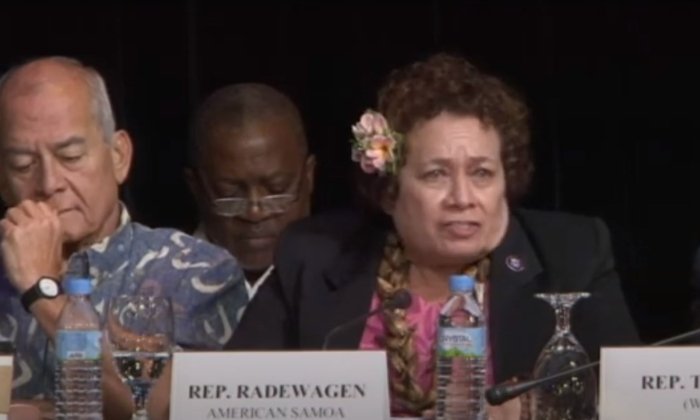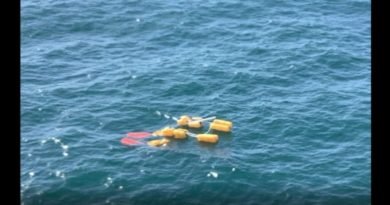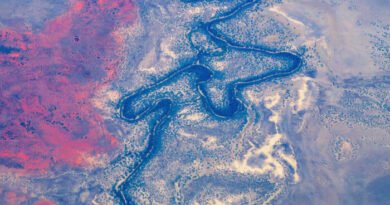US Territories and Allies Express Concern Over CCP Subversion, Highlighting Security and Sovereignty Threats
Irene Sgambelluri was 10 years old on Dec. 8, 1941, when Japanese forces seized Guam while simultaneously striking Hawaii, the Philippines, Malaysia, and Sumatra to quickly conquer Southeast Asia and ignite a war that still scars scattered islands across the Pacific.
A native Chamorro, she recalls that day was the Feast of Santa Marian Kamalen, Guam’s patron saint, a festive occasion for the island’s large Catholic community.
But there would be nothing to celebrate that day, nor for years to come, Ms. Sgambelluri, 92, testified (pdf) during an Aug. 24 House Natural Resources Committee Indo-Pacific Task Force field hearing in Tamuning, Guam.
Related Stories
“War ripped my family apart and took away every aspect of life I had known up until that point,” she said. Her father, a U.S. Navy pharmacist, was shipped to Japan as a slave-labor prisoner of war. “I never had a chance to say goodbye and I feared I would never see him again.”
While her father returned after the allies won the war nearly four years later, memories of the occupation remain “agonizing,” Ms. Sgambelluri said, but she felt compelled to testify before the panel so “history cannot repeat itself.”
“Japan attacked us because of our strategic and important location in the Pacific. With control of Guam, Japan could control the Pacific,” she said. “China sees the importance of Pacific islands as well. However, we will not let them have control over Guam and the Pacific region.”
Ms. Sgambelluri was among nine witnesses who spoke during the nine-member bipartisan task force’s “Peace Through Strength: The Strategic Importance of the Pacific Islands to U.S.-led Global Security” presentation that featured stark testimony from territorial governors and government officials about growing coercion and overt threats from China.
“Like the empire of Japan did, the [China] aims to dominate the Pacific and Island people,” Indo-Pacific Task Force Chair Rep. Bruce Westerman (R-Ark.) said. “We’re here today at a pivotal point in our nation’s history. Less than 2,000 miles away lays a threat to America and our allies. The People’s Republic of China, under the tyranny of the Chinese Communist Party (CCP), not only seeks to challenge American leadership, but it’s aggressively working to undermine the democratic values and institutions that we cherish,” using the official name of China under the control of the CCP.
Graphic showing ports in the Pacific, with a highlight of ports China has helped developed, leased, or expressed interest in funding. (Reuters/Government Agencies)
‘Blue Continent’ Compacts
Leaders from three central and western Pacific U.S. territories, including Guam, and three freely associated states collectively representing 425,000 people living on more than 2,140 islands across 212 million miles of the “Blue Continent”—where more than $2 trillion in U.S. trade was generated in 2022—cited aggressive menacing by Chinese aircraft and ships, illegal fishing, cyber-attacks, and said CCP officials use bribery and anti-American propaganda to subvert governments and institutions.
“I know it’s hard for some Americans to understand why any of this matters to their way of life. After all, Guam and the Pacific Islands are thousands of miles away,” Guam Gov. Lourdes Leon Guerrero testified (pdf). “Put simply, because Guam can project power throughout the Indo-Pacific region, China is working to project equal power onto Guam and its sister islands. Yes, Guam has always been considered the ‘Tip of the American Spear’ in the Pacific, but [CCP subterfuge] has brought with it specific consequences for the people of Guam.”
Del. Amura Amata Radewagen (R-American Samoa), a non-voting congressional representative, said the territories and freely associated states “form the western-most of America’s homelands at the doorstep of Asia” and the “architecture of the what, since 1945, has been mostly a free and open Pacific,” an “integrated superstructure of regional security and peace” that must be reinforced.
The near-three hour Congressional hearing, the first on Guam in 15 years, started about 10:10 a.m. Aug. 24 at the Hilton Hotel on Tumon Bay. It was still in its first hour when eight Republican presidential candidates took the stage for their 8 p.m. Aug. 23 debate in Milwaukee, Wisconsin, 7,318 miles east and seven time zones, 15 clock hours “behind” Guam, “Where America’s Day Begins.”
The hearing was one of several the task force plans in August across the Pacific and comes as the Biden administration negotiates renewals of 20-year ‘Compacts of Free Association’ (COFA) with the three independent island nations and promotes its “Pacific Partnership Strategy,” which calls for “renewed U.S. engagement across the full Pacific Islands region” to counter China’s “efforts at democratic erosion.”
The administration submitted its proposed compacts to Congress in June after years of often difficult deliberations with the three island nations—the Federated States of Micronesia (FSM), the Republic of Marshall Islands (RMI), and the Republic of Palau.
The Biden administration’s proposed compact earmarks $7.1 billion in economic assistance over a 20-year span for the three nations with $3.3 billion earmarked for FSM, a $1.2 billion increase from the 2003 US-FSM COFA, and $2.3 billion for RMI, a $1.3 billion increase from the 2003 US-RMI COFA.
The plan also includes $634 million for the U.S. Postal Services to provide services to FSM and RMI.
Former U.S. Secretary of State Mike Pompeo (L), former Federated States of Micronesia President David Panuelo, and former Marshall Islands President Hilda Heine (R) meet in Kolonia, Federated States of Micronesia, on Aug. 5, 2019. (Jonathan Ernst/Reuters)
‘Political Warfare’
According to a 13-page brief (pdf) written by Indo-Pacific Task Force analysts Ken Degenfelder, Justin Rhee, and Howard Hills, China has been expanding its influence across the region for more than a decade as part of its Belt and Road Initiative “to invest in more than 150 countries and international organizations, and expand CCP influence.”
Standard tactics include economic aid and infrastructure development proposals “leveraged to affect political outcomes and perceptions of the U.S. while waging ‘political warfare’ to gain undue influence and/or destabilize island nations,” they write.
The CCP has been successful, the task force analysis maintains, not only in using “offerings of economic aid and infrastructure development” to seduce government and business leaders but to become “an important market for [island economies] when it comes to natural resource exports and tourism,” an industry it artificially boosted and is now using as leverage against the island nations and U.S. territories.
The way in which China is “undermining strategic and economic interests in the area is by trying to reshape narratives, even to retell history to align with their own diplomatic and economic interests,” Rep. Melanie Stansbury (D-N.M.) said, which is why Ms. Sgambelluri’s horrific recount is “important testimony” reaffirming a “painful history” that warns “we know what happens if we let democracy slip away.”
When resisted, the CCP has resorted to bribery, “political warfare,” and other “malign tactics … that aggressively threaten the political stability” of the freely associated states, the analysis states, before warning, “U.S. territories are not immune from being targeted” by China.
Indeed, agreed Ms. Leon Guerrero, Guam’s first-term governor and former Bank of Guam president/CEO, the CCP “has shown a commitment to its goals” to “increase its popularity in the Pacific region and gain support for pro-Chinese policies at the United Nations.”
Key to that overall goal, she said, is promoting the CCP’s “China-Pacific Island Countries Common Development Vision” and the “China-Pacific Island Countries Five-Year Action Plan on Common Development (2022-26).”“Knowing that,” Ms. Leon Guerrero asked, “who should write the rules of U.S. trade in the Indo-Pacific? If we choose not to, China surely will. This is why I support the bipartisan effort to increase U.S. engagement throughout the region and invest in the security of Guam and other vital U.S. territories. It is why I join other island leaders in seeking economic and infrastructure support for the Pacific’s developing democracies.”
A U.S. Air Force fire truck sprays water near plane hangars at Andersen Air Force base in Yigo, Guam, on Aug 17, 2017. (Justin Sullivan/Getty Images)
Guam Under the Gun
The largest, most populous, and southernmost of the Mariana Archipelago island chain, 212-square-mile Guam has been part of the United States since the Spanish-American War at the dawn of the 20th century and is governed as a U.S. territory under the 1950 Organic Act of Guam.
Along with the Commonwealth of the Northern Marianas Islands (CNMI) and American Samoa, it is one of three Pacific U.S. territories that have evolved since World War 2 into an important military nexus, critical trade corridor, and key source for raw materials and minerals with vibrant tourism and sports-fishing industries that draw visitors primarily from Japan, South Korea, China, and Taiwan
Source link




